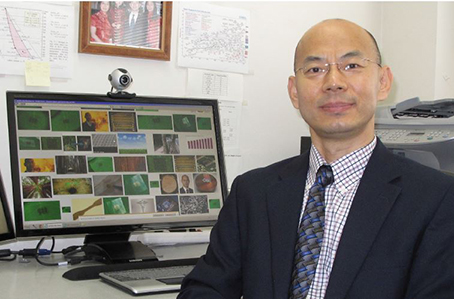
The practical philosopher
Jack Ma wants to push computing to the fringes of science fiction. He’s going back to square one to do it.
When an Intel team recently unveiled the world’s first silicon laser chip, headlines proclaimed the “death of copper cables” and “computing at the speed of light.”
The principle is elegant – replace the metal wiring between components with optical connections.
Today’s computers depend on wire to move data. A single processor holds billions of transistors, each strung together with copper. The big data centers of Google and Facebook are steaming jungles of cables. Cooling accounts for half the operating costs, explains Zhenqiang “Jack” Ma, a UW-Madison professor of electrical and computer engineering.
Trading those wires for laser beams has breathtaking consequences. Picture ultra-efficient servers, superfast laptops and data flying at 50 gigabits or more per second. That’s fast enough to download a hi-def movie in less than one second.
Of course, fiber optic communication is already routine on the continental scale. Miles of fiber bundles crisscross the ocean floor to connect Internet users from London to New York, for example. But bringing that capability down to the chip level represents a new frontier.
The push towards a fiber optic revolution is attracting many dreamers, including Ma. He says that the technology is young and complicated. But industry has thrown the gauntlet, and researchers around the world are spoiling for the challenge.
There’s a long way to go. Sitting at his computer in Engineering Hall, Ma points to his office wall.
“It’s still all metal wires behind there,” he says.
One challenge of bringing fiber optical technology down to the chip level is translating between electrical signals and light pulses. One of the keys, says Ma, is building a better laser. It must be much thinner than a human hair and almost weightless. It must fit comfortably on a silicon chip. It must be practical, efficient and compatible with semiconductor processing methods.
Ma thinks he’s done it.
He and his collaborators have developed a new way to fabricate an ultra-compact laser (called a vertical cavity surface-emitting laser or VCSEL) thinner than 2 micrometers. It is so slim because it utilizes a single crystal membrane or film as a reflector.
“Put it on silicon and it won’t feel like anything,” says Ma. “The footprint is very small.”
He says support from the Accelerator Program enabled the team to achieve a major milestone in the prototyping process.
“Accelerator gave us the most critical funding to help us realize the last step that was needed,” he says. “We now have an approach, a methodology, a way to tell industry yes, we can do this.”
Next, they plan to test the laser on a commercial chip, optimize the design and prove it’s ready for prime time.
Ma is optimistic about licensing prospects and continues to work closely with WARF. He understands that catching industry’s ear takes time, determination and extraordinary data.
But he knows how to make a splash.
Last spring, Ma made news of his own when he and a group of collaborators from academia and business landed a $4 million grant from the Department of Defense. The team plans to develop new ultraviolet lasers based on technology Ma patented through WARF several years ago.
One application could help soldiers in the field identify hazardous materials like explosives or biological agents. Imagine a laser pointer that reveals roadside bombs, he says.
Ma’s staggering workload (his project list is 35 lines deep) goes well beyond lasers. His research interests have made him something of a celebrity.
Many national outlets including the Wall Street Journal and Fox Business recently covered his work on biodegradable computer chips. By replacing the substrate with a cellulose material derived from wood, Ma says you could drop a chip in the forest and fungus would degrade it. The research may someday help alleviate the 3.2 million tons of electronic waste generated in the U.S. every year.
Ma, who pursued seven majors in 15 years before obtaining his Ph.D., says a broad knowledge base fuels his curiosity.
“I never stop studying or thinking. I know where the problems are,” he says.
One source of inspiration is more unusual – philosophy.
Ma says the dialectical principles he learned in his youth teach him to approach problems from their root, taking nothing for granted. He explains that when concepts are pushed to their extreme, they change properties.
Some of his core engineering insights derive from this principle. He offers an example. “When metal wire, a conductor, is made extremely thin, then what does it become? An insulator or resistor.”
“I teach my students to question from the fundamental level. I guess I’m a practical philosopher,” he laughs.
His latest project illustrates the point. He describes a phenomenon called “efficiency droop” in light emitting diodes (LEDs). In essence, less light is produced at higher currents. It’s a problem that puzzled scientists up until a few years ago and contributes to the relatively high cost of LED bulbs. “It’s been 22 years since the blue LED was invented and no one can solve the problem,” he says.
Ma thinks he can, and hopes to build a new and improved prototype. (Blue LEDs are a critical component to making white light.)
The preliminary data is wildly exciting. He thinks he can achieve at least 40 times more light production than the best LEDs currently on the market, without sacrificing efficiency.
“It’s the philosophy again,” he says. “I’m taking this on from the root.”